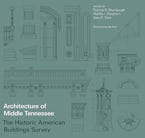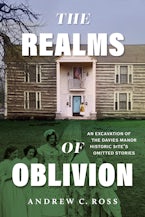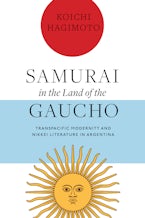- Home
- Vintage Vanderbilt
- Architecture of Middle Tennessee

Architecture of Middle Tennessee
The Historic American Buildings Survey
Edited by Thomas B. Brumbaugh, Martha I. Strayhorn and Gary G. Gore
Series: Vintage Vanderbilt
First published in 1974, Architecture of Middle Tennessee quickly became a record of some of the region's most important and most endangered buildings. Based primarily upon photographs, measured drawings, and historical and architectural information assembled by the Historic American Buildings Survey of the National Park Service in 1970 and 1971, the book was conceived of as a record of buildings preservationists assumed would soon be lost. Remarkably, though, nearly half a century later, most of the buildings featured in the book are still standing.
Vanderbilt staffers discovered a treasure trove of photos and diagrams from the HABS survey that did not make the original edition in the Press archives. This new, expanded edition contains all of the original text and images from the first volume, plus many of the forgotten archived materials collected by HABS in the 1970s.
In her new introduction to this reissue, Aja Bain discusses why these buildings were saved and wonders about what lessons preservationists can learn now about how to preserve a wider swath of our shared history.
Vanderbilt staffers discovered a treasure trove of photos and diagrams from the HABS survey that did not make the original edition in the Press archives. This new, expanded edition contains all of the original text and images from the first volume, plus many of the forgotten archived materials collected by HABS in the 1970s.
In her new introduction to this reissue, Aja Bain discusses why these buildings were saved and wonders about what lessons preservationists can learn now about how to preserve a wider swath of our shared history.
The Historic American Buildings Survey
Foreword to the New Edition
Preface
Acknowledgments
Government & Public Buildings
Tennessee State Capitol (Nashville), 1845–1859
Tennessee State Penitentiary (Nashville), 1895–1897
Federal Building (Old Clarksville Post Office), 1897–1898
Commercial Structures
Poston Buildings (Clarksville), ca. 1843
S. D. Morgan and Company (Nashville), 1856
Grange Warehouse (Clarksville), 1858 or 1859
Second Avenue, North, Commercial District (Nashville), 1896–1920(?)
Werthan Bag Corporation (Nashville), 1871–1880s
Bear Spring Furnace (Dover), 1873
Ryman Auditorium (Nashville), 1888–1892
Union Station (Nashville), 1898–1900
Public Arcade (Nashville), 1902
Churches
St. Mary’s Cathedral (Nashville), 1844–1847
First Presbyterian Church (Nashville), 1849–1851
Zion Presbyterian Church (Columbia), 1849
Holy Trinity Episcopal Church (Nashville), 1852–1887
Schools, Institutions
University of Nashville—Children’s Museum (Nashville), 1853
Jubilee Hall, Fisk University (Nashville), 1876
Vanderbilt University Gymnasium (Nashville), 1880
West Side Row, Vanderbilt University (Nashville), 1886–1887
Residences
Rock Castle (Hendersonville), 1784–1797(?)
Hays-Kiser House (Antioch), ca. 1796
Travellers’ Rest (Nashville), 1799–1885
Cragfont (Gallatin), 1802
Oaklands (Murfreesboro), 1815, 1825, 1859–1860
The Hermitage (Nashville), 1819
Wessyngton (Robertson County), 1819
Castalian Springs—Wynnewood (Gallatin), 1828
Carter House (Franklin), 1830
Fairvue (Gallatin), 1832
Rattle and Snap (Columbia), 1845
Adolphus Heiman House (Nashville), 1845–1850(?)
Belmont (Nashville), 1850
Worker’s House (Nashville), ca. 1850
Two Rivers (Nashville), 1859
Epilogue
Notes from 2020
Foreword to the New Edition
Preface
Acknowledgments
Government & Public Buildings
Tennessee State Capitol (Nashville), 1845–1859
Tennessee State Penitentiary (Nashville), 1895–1897
Federal Building (Old Clarksville Post Office), 1897–1898
Commercial Structures
Poston Buildings (Clarksville), ca. 1843
S. D. Morgan and Company (Nashville), 1856
Grange Warehouse (Clarksville), 1858 or 1859
Second Avenue, North, Commercial District (Nashville), 1896–1920(?)
Werthan Bag Corporation (Nashville), 1871–1880s
Bear Spring Furnace (Dover), 1873
Ryman Auditorium (Nashville), 1888–1892
Union Station (Nashville), 1898–1900
Public Arcade (Nashville), 1902
Churches
St. Mary’s Cathedral (Nashville), 1844–1847
First Presbyterian Church (Nashville), 1849–1851
Zion Presbyterian Church (Columbia), 1849
Holy Trinity Episcopal Church (Nashville), 1852–1887
Schools, Institutions
University of Nashville—Children’s Museum (Nashville), 1853
Jubilee Hall, Fisk University (Nashville), 1876
Vanderbilt University Gymnasium (Nashville), 1880
West Side Row, Vanderbilt University (Nashville), 1886–1887
Residences
Rock Castle (Hendersonville), 1784–1797(?)
Hays-Kiser House (Antioch), ca. 1796
Travellers’ Rest (Nashville), 1799–1885
Cragfont (Gallatin), 1802
Oaklands (Murfreesboro), 1815, 1825, 1859–1860
The Hermitage (Nashville), 1819
Wessyngton (Robertson County), 1819
Castalian Springs—Wynnewood (Gallatin), 1828
Carter House (Franklin), 1830
Fairvue (Gallatin), 1832
Rattle and Snap (Columbia), 1845
Adolphus Heiman House (Nashville), 1845–1850(?)
Belmont (Nashville), 1850
Worker’s House (Nashville), ca. 1850
Two Rivers (Nashville), 1859
Epilogue
Notes from 2020
Thomas B. Brumbaugh, a native of Pennsylvania, was a professor of fine arts at Vanderbilt University.
Martha I. Strayhorn and Gary G. Gore were both staff members at Vanderbilt University Press during the time of the book's original publication.
Aja Bain is program and publications manager for the American Association for State and Local History, where she is the editor of History News magazine. She also serves as president of the Inter-Museum Council of Nashville and on the board of Historic Nashville, Inc.
(From the Foreword to the Paperback Edition)
When Vanderbilt University Press first approached me about writing a new foreword to a reissued book on local historic preservation from 1974, I was delighted and almost incredulous to hear that most of the buildings included were still standing. Nashville’s unprecedented growth is a dream for some and a nightmare for others, but no one can deny that one of the most visible manifestations of this reality has been the decimation of our historic landscape. Was this book a talisman? Did inclusion provide structures with some sort of protection against the city’s indifferent cannibalization of the places that form its character and sustain its people? I was enthusiastic, but a bit wary.
Then I received the publication: a selection of “thirty-five interesting and important structures representative of Middle Tennessee’s rich architectural heritage” drawn from the Historic American Buildings Survey work done in the state in the early 1970s. Complete with descriptions, photos, and architectural drawings, the book was edited primarily by Thomas B. Brumbaugh, then a professor of fine arts at Vanderbilt. Iconic structures like the Ryman Auditorium and Union Station were included alongside lesser-known gems like Holy Trinity Episcopal Church (now Church of the Holy Trinity) and, further afield, the Poston Buildings in Clarksville and Bear Spring Furnace in Dover. Working with a limited palette of pre-1920 structures (adhering to preservation’s apocryphal “fifty-year rule”) and a marked preference for classical and monumental forms, Brumbaugh assembled a respectable grouping of governmental, commercial, religious, institutional, and residential buildings that neatly embodies the preservation and public history standards of its time.
The book itself, then, is an artifact, a snapshot of the preservation ideals of the country on the cusp of the Bicentennial and its subsequent history and nostalgia boom. It is also a time capsule of our region (but primarily Nashville) at the transitional moment when it was redefining its role in the New Sunbelt South and its relationship to the past. Brumbaugh presciently warns the city of emulating too closely “dead Athens, that most cruelly vandalized of ancient cities,” and points us instead toward the model of Amsterdam, a bustling modern city that nonetheless preserves and cherishes its past.
If this work is so much a product of its time, why reissue it? Why share these half-century-old descriptions and views of structures, many of which one can visit today, which even Brumbaugh admits are not fully representative of the region’s architectural heritage? What is this book’s purpose in Nashville in 2020 and beyond?
Architecture of Middle Tennessee is a microhistory of the preservation field itself, with all its shifting biases, prejudices, and assumptions. It is a lens through which to view the evolution of preservation ideals and practices in our region and a roadmap for measuring how far we’ve traveled. It’s a behind-the-scenes look at history production and the way societies construct a past that suits them through the built landscape. It’s a potent manifestation of the dangers of survival bias. It’s both a warning and a catalyst for hope.
When Vanderbilt University Press first approached me about writing a new foreword to a reissued book on local historic preservation from 1974, I was delighted and almost incredulous to hear that most of the buildings included were still standing. Nashville’s unprecedented growth is a dream for some and a nightmare for others, but no one can deny that one of the most visible manifestations of this reality has been the decimation of our historic landscape. Was this book a talisman? Did inclusion provide structures with some sort of protection against the city’s indifferent cannibalization of the places that form its character and sustain its people? I was enthusiastic, but a bit wary.
Then I received the publication: a selection of “thirty-five interesting and important structures representative of Middle Tennessee’s rich architectural heritage” drawn from the Historic American Buildings Survey work done in the state in the early 1970s. Complete with descriptions, photos, and architectural drawings, the book was edited primarily by Thomas B. Brumbaugh, then a professor of fine arts at Vanderbilt. Iconic structures like the Ryman Auditorium and Union Station were included alongside lesser-known gems like Holy Trinity Episcopal Church (now Church of the Holy Trinity) and, further afield, the Poston Buildings in Clarksville and Bear Spring Furnace in Dover. Working with a limited palette of pre-1920 structures (adhering to preservation’s apocryphal “fifty-year rule”) and a marked preference for classical and monumental forms, Brumbaugh assembled a respectable grouping of governmental, commercial, religious, institutional, and residential buildings that neatly embodies the preservation and public history standards of its time.
The book itself, then, is an artifact, a snapshot of the preservation ideals of the country on the cusp of the Bicentennial and its subsequent history and nostalgia boom. It is also a time capsule of our region (but primarily Nashville) at the transitional moment when it was redefining its role in the New Sunbelt South and its relationship to the past. Brumbaugh presciently warns the city of emulating too closely “dead Athens, that most cruelly vandalized of ancient cities,” and points us instead toward the model of Amsterdam, a bustling modern city that nonetheless preserves and cherishes its past.
If this work is so much a product of its time, why reissue it? Why share these half-century-old descriptions and views of structures, many of which one can visit today, which even Brumbaugh admits are not fully representative of the region’s architectural heritage? What is this book’s purpose in Nashville in 2020 and beyond?
Architecture of Middle Tennessee is a microhistory of the preservation field itself, with all its shifting biases, prejudices, and assumptions. It is a lens through which to view the evolution of preservation ideals and practices in our region and a roadmap for measuring how far we’ve traveled. It’s a behind-the-scenes look at history production and the way societies construct a past that suits them through the built landscape. It’s a potent manifestation of the dangers of survival bias. It’s both a warning and a catalyst for hope.











